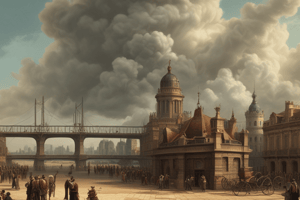Podcast
Questions and Answers
What is the primary purpose of Robotic Process Automation (RPA)?
What is the primary purpose of Robotic Process Automation (RPA)?
- To develop enterprise software with agile relationships
- To analyze big data and reveal patterns
- To build user interfaces with JavaScript libraries
- To handle high-volume, repeatable tasks that previously required humans (correct)
What is the main characteristic of Intelligent Apps (I-Apps)?
What is the main characteristic of Intelligent Apps (I-Apps)?
- They provide personalized and adaptive user experiences (correct)
- They rely on 5G networks for data transfer
- They are built using Angular JavaScript framework
- They use machine learning to analyze big data
What is the key difference between Angular and React?
What is the key difference between Angular and React?
- Angular is used for building I-Apps while React is used for RPA
- Angular is used for 5G networks while React is used for IoT
- Angular is a complete JavaScript framework while React is a library (correct)
- Angular is a JavaScript library while React is a framework
What is the primary goal of DevOps in enterprise software development?
What is the primary goal of DevOps in enterprise software development?
What is the main application of 5G networks?
What is the main application of 5G networks?
What is the primary benefit of adapting to emerging technologies?
What is the primary benefit of adapting to emerging technologies?
What is the primary characteristic of Big Data?
What is the primary characteristic of Big Data?
What is the primary function of IoT devices?
What is the primary function of IoT devices?
What is the primary goal of using Intelligent Apps (I-Apps)?
What is the primary goal of using Intelligent Apps (I-Apps)?
What is the key benefit of using DevOps in enterprise software development?
What is the key benefit of using DevOps in enterprise software development?
Study Notes
Industrial Revolution
- The Industrial Revolution was a period of major industrialization and innovation that took place during the late 1700s and early 1800s.
- It shifted society from using tools to make products to using new sources of energy, such as coal, to power machines in factories.
- The revolution started in England, with a series of innovations to make labor more efficient and productive.
Types of Industries
- The primary industry involves getting raw materials (e.g., mining, farming, and fishing).
- The secondary industry involves manufacturing (e.g., making cars and steel).
Industrial Revolutions
- The First Industrial Revolution was characterized by the use of steam power.
- The Second Industrial Revolution, also known as the American Industrial Revolution, started between 1820 and 1870, and was characterized by the widespread use of mass production and assembly lines using electricity.
- The Third Industrial Revolution was characterized by the adoption of computers and automation.
- The Fourth Industrial Revolution is characterized by smart and autonomous systems fueled by data and machine learning.
Technologies for Emerging Technologies
- Data is regarded as the new oil and strategic asset, driving innovation and economic opportunities.
Emerging Technologies
- Artificial Intelligence: the theory and development of computer systems able to perform tasks normally requiring human intelligence.
- Augmented Reality: a technology that superimposes a computer-generated image on a user's view of the real world.
- Virtual Reality: a computer-generated simulation of a 3D image or environment that can be interacted with in a seemingly real or physical way.
- Blockchain: a system in which a record of transactions made for bitcoin or another cryptocurrency are maintained across several computers linked in a peer-to-peer network.
- Cloud Computing: the practice of using a network of remote servers hosted on the Internet to store, manage, and process data.
- DevOps: an enterprise software development phrase used to mean a type of agile relationship between development and IT operations.
- Intelligent Apps (I-Apps): applications that use historical and real-time data to make predictions and suggestions, delivering personalized and adaptive user experiences.
- Big Data: extremely large data sets that may be analyzed computationally to reveal patterns, trends, and associations.
- Robotic Processor Automation (RPA): the use of software with artificial intelligence (AI) and machine learning capabilities to handle high-volume, repeatable tasks.
- Internet of Things (IoT): a system of interrelated computing devices, mechanical and digital machines provided with unique identifiers and the ability to transfer data over a network without requiring human-to-human or human-to-computer interaction.
- Angular and React: JavaScript framework and library for building user interfaces.
- 5G Networks: the fifth generation wireless technology for digital cellular networks.
Studying That Suits You
Use AI to generate personalized quizzes and flashcards to suit your learning preferences.
Description
Test your knowledge of the industrial revolutions and emerging technologies that have shaped the world. From mechanization to automation, and from mass production to smart and autonomous systems, see how much you know about the technological advancements that have transformed industries. This quiz covers the key concepts and innovations that have led to the development of autonomous vehicles and automated robots.




